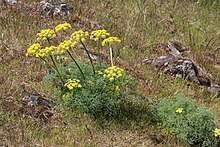| Lomatium grayi | |
|---|---|

| |
| Conservation status | |
 Secure (NatureServe) | |
| Scientific classification | |
| Kingdom: | Plantae |
| Clade: | Tracheophytes |
| Clade: | Angiosperms |
| Clade: | Eudicots |
| Clade: | Asterids |
| Order: | Apiales |
| Family: | Apiaceae |
| Genus: | Lomatium |
| Species: | L. grayi |
| Binomial name | |
| Lomatium grayi (J.M.Coult. & Rose) J.M.Coult. & Rose | |
Lomatium grayi, commonly known as Gray's biscuitroot, Gray's desert parsley, or pungent desert parsley, is a perennial herb of the family Apiaceae. It is native to Western Canada in British Columbia, and the Western United States, including from the Eastern Cascades and northeastern California to the Rocky Mountains.
It is a perennial herb found growing in dry rocky banks and slopes. It grows throughout the sagebrush steppe and also in pinyon–juniper woodland. It has a lifespan of 5–7 years.
Description

Lomatium grayi has glabrous stems that split at the ground, and a long, thick taproot. The dark-green leaves are numerously divided. It flowers from March to July with 1–20 compound umbels, each with hundreds of yellow flowers, upon leafless stalks. The fruit is glabrous, elliptic, 8–15 mm long, with the lateral wings about half as wide as the body. The plant has a strong odor resembling parsley.
- Varieties
- Lomatium grayi var. depauperatum (M.E. Jones) Mathias; endemic to northeastern Nevada and northwestern Utah.
- Lomatium grayi var. grayi
Taxonomy
A 2018 study has proposed splitting L. grayi into four species, based on morphometric analysis: Lomatium klickitatense in Klickitat County, Washington and surrounding areas; Lomatium papilioniferum in the rest of the Pacific Northwest; Lomatium depauperatum (formerly L. grayi var. depauperatum) in western Utah and eastern Nevada; and Lomatium grayi s.s. in the western Rocky Mountains and adjoining basins.
Uses
The plant was used as a food source by the Northern Paiute people in Oregon; new tender stems were eaten raw, and the roots were a winter starvation food.
References
- USDA: Lomatium grayi; info + native distribution map . Accessed 8 January 2013.
- Consortium of California Herbaria (Jepson): Lomatium grayi distribution. Accessed 8 January 2013.
- ^ Lomatium grayi in Jepson Flora Project (eds.) Jepson eFlora, info + detailed distribution map . Accessed 8 January 2013.
- ^ Taylor, Ronald J. (1994) . Sagebrush Country: A Wildflower Sanctuary (rev. ed.). Missoula, MT: Mountain Press Pub. Co. p. 96. ISBN 0-87842-280-3. OCLC 25708726.
- ^ Burke Museum—WTU Herbarium: Lomatium grayi — info + images. Accessed 8 January 2013.
- Burke Museum—WTU Herbarium: Lomatium papilioniferum. Accessed 22 May 2021.
- USDA Plants Profile: Lomatium grayi var. depauperatum — (Gray's biscuitroot) . Accessed 8 January 2013.
- USDA: Lomatium grayi var. depauperatum — (Gray's biscuitroot) . Accessed 8 January 2013.
- Alexander, J. A.; Whaley, W.; Blain, N. (2018). "The Lomatium grayi complex (Apiaceae) of the western United States: a taxonomic revision based on morphometric, essential oil composition, and larva-host coevolution studies". Journal of the Botanical Research Institute of Texas. 12 (2): 387–444. doi:10.17348/jbrit.v12.i2.945. S2CID 244520142.
- Native American Ethnobotany (University of Michigan - Dearborn) . Accessed 8 January 2013.
External links
- USDA Plants Profile: Lomatium grayi (Gray's biscuitroot)
- Jepson eFlora treatment: Lomatium grayi
- Lomatium grayi — U.C. Photo gallery
| Taxon identifiers | |
|---|---|
| Lomatium grayi |
|
| Peucedanum grayi | |
- NatureServe secure species
- Lomatium
- Flora of British Columbia
- Flora of California
- Flora of Colorado
- Flora of Idaho
- Flora of Nevada
- Flora of New Mexico
- Flora of Oregon
- Flora of Utah
- Flora of Washington (state)
- Flora of Wyoming
- Flora of the Great Basin
- Flora of the Rocky Mountains
- Flora of the Western United States
- Taxa named by John Merle Coulter